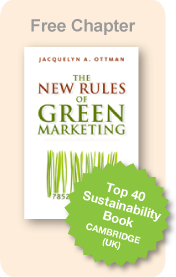Jacquie Ottman's
Green Marketing Blog
What Green Consumer Polls Should Really Be Asking
May 04, 2012 by Jacquelyn Ottman
 Ever since the resurgence of environmentalism in 1990, consumer polls have attempted to measure awareness, attitudes and behaviors towards environmental issues and products. Poll after poll has found that consumers claim to be concerned about the issues, they report high levels of green product purchase, and even claim willingness to pay a premium for greener products and packages.
Ever since the resurgence of environmentalism in 1990, consumer polls have attempted to measure awareness, attitudes and behaviors towards environmental issues and products. Poll after poll has found that consumers claim to be concerned about the issues, they report high levels of green product purchase, and even claim willingness to pay a premium for greener products and packages.
But empirical evidence doesn’t seem to jibe with the research. In some markets, green products barely eke out 3% share, in contrast to the near majorities of consumers who express to pollsters interest in all things green. And despite consumer pronouncements otherwise, premium-priced green brands often gather dust on shelves.
What can explain the gap between the polls and actual in-market performance? Are consumers lying to pollsters in an attempt to look virtuous? Is the spirit willing but the pocketbook weak? Or is it possible that we ourselves need to change the way we view the green consumer market — and ask different questions? I suspect the latter.
What is “green” — exactly?
One of the biggest challenges in defining “green”, whether it be consumers, products or ads, is that “green,” like the planet itself, encompasses everything — air, water, biological life, chemicals, energy, you name it.
When it comes to zeroing in on “green” products, what constitutes “green” can run the entire gamut of one or more attributes spanning a product’s lifecycle starting with raw materials (“sustainably harvested”, “organic” and “recycled”), right through to disposal (“compostable”, “recyclable,”) — and everything in between.
And most consumers can be said to be “green” in some way. For instance, NMI’s 2011 US LOHAS Consumers Trends Database found that 83% — an overwhelming majority of consumers — said they identified with green at some level. (Who wouldn’t be for green?).
So when majorities of consumers say they are concerned about environmental issues and express interest in buying green products and recycling their newspapers and bottles, chances are they are telling the truth.
Consumers may think they are actually greener than we give them credit for.
Is it possible that polls may overstate green consumer purchasing and behavior because consumers think that some of the conventional products they buy are actually green?
Consider the language on the back of bottle of Tide. Every bottle of Tide, and many other big laundry detergent brands, too, now carries a recycling label and these messages: “Bottle made from 25% or more post-consumer plastic,” “Contains no phosphates,” “Ingredients include biodegradable surfactants (anionic and nonionic) and enzymes.” This all sounds pretty green to me!
Even without such language, is it possible that consumers may believe that trusted brands from reputable companies are “green” — or that the government is watching out?
Do greener products need to scream green via eco-logos and images of planets, babies and daisies to merit a check mark in the “green” column? Consider, too that white vinegar and baking soda have long been touted as green cleaning aids but don’t sport eco-logos of any stripe.
There may not even be such as thing as “green” marketing.
When the FTC Green Guides are issued in revised form (likely this year), what are referred to as “generalized environmental claims” will most likely be discouraged. So “green” marketing is really an umbrella term for educating consumers about the various specific environmental benefits and attributes of one’s products or company. Babies, planets and daisies are quickly disappearing from the vernacular and in their place are claims for particular environmental attributes.
So the answers to the $64,000 dollar questions of green marketing: Who is the “green” consumer and will she pay a premium for green? may be that all (or, okay, most ) consumers are green consumers since most consumers may think they are already buying green products, however they may define them. And the extent to which they are willing to pay a premium may be no different for “green” than other products and that is: Do they provide value?
The Path Forward
What we seem to be dealing with, then, is a question of semantics, and the challenge of knowing which questions to ask to help us understand green market opportunities. “Green” is a cozy, easy to remember term, but it may not be so useful in communicating with consumers who likely have their own interpretations of “green” expressed throughout their day-to-day lives. And misleading polls results don’t help to build credibility for investment among skeptical businesspeople who for the past 20-plus years have been hearing that consumers “don’t care” and “won’t pay a premium”.
To those willing to take a shot at rebuilding interest and credibility in all things “green”, remember three important things: 1) Most consumers want to do the right thing. They want clean air and clean water, healthful food to eat, litter-free parks and beaches to play in, and energy to run their lives; 2) Whether it be keeping their bathtub clean, saving for retirement, driving the speed limit or eating healthfully, all consumers tend to overstate virtuous behavior to pollsters. (More than we would like, they report the person they aspire to be, or who they are just part of the time.) And; 3) just like for all products, most consumers will only pay a premium when products demonstrate genuine added value.
Although it might take a little doing, most consumers have the wherewithal to understand the building blocks of “green”, e.g., “recycled”, “recyclable” and “biodegradable”. Happily, businesses have the wherewithal to address consumers’ needs and to do it sustainably. Their motivations: a competitive advantage, profits, brand loyalty, motivated employees, the ability to innovate, and the promise of a business that will be sustained over time.
My book, The New Rules of Green Marketing includes detailed strategies and tools for businesses looking to positively address consumers’ environmental consciousness without fear of backlash. On the top of the list, is the need for customized research to understand one’s own consumers’ attitudes and awareness of specific environmental attributes, including carefully segmenting the marketplace, and marketing one’s products accordingly.
Jacquelyn Ottman is an expert adviser on green marketing to Fortune 500 firms, entreprenuerial companies, and the U.S. government. She is the author of The New Rules of Green Marketing: Strategies, Tools and Inspiration for Sustainable Branding (Berrett-Koehler, 2011)
This was originally published in Huffington Post on May 3, 2012
Recent blog posts:
• Shop ‘Til You Drop-but on Earth Day?
• Swap, Don’t Shop: Making Green in the Sharing Economy
• Heineken Launches Sustainable Packaging Challenge
Subscribe to Jacquie Ottman’s Green Marketing Blog. Link here.



 ShareThis
ShareThis

